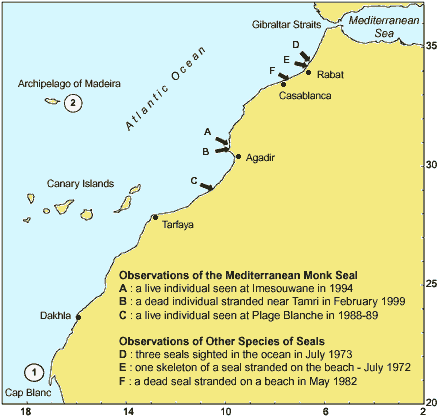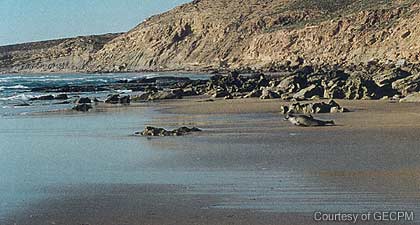FURTHER OBSERVATIONS OF MEDITERRANEAN MONK SEALS
ON THE NORTH ATLANTIC COASTS OF MOROCCO
A. Bayed
Groupe d’Etude des Cétacés et Pinnipèdes du Maroc (GECPM),
Université Mohammed V - Agdal
Institut Scientifique, B.P. 703, Agdal
10106 Rabat – Morocco
e-mail: bayed@israbat.ac.ma
The Mediterranean monk seal Monachus monachus is known from the Black Sea, the Mediterranean, and the northwest coast of Africa as far south as Gambia. In the Atlantic, the most important populations are in Madeira and along the Cap Blanc peninsula, in the south of Morocco.
On the Atlantic Moroccan coast, between the Straits of Gibraltar and Agadir, recorded observations of Mediterranean monk seals are few and relatively old (Bayed & Beaubrun 1987). In spite of the research efforts undertaken by a network of observers coordinated by the Groupe d'Etude des Cétacés et Pinnipèdes du Maroc (GECPM) based at the Institut Scientifique of Rabat, only three reliable sightings of Mediterranean monk seals have been added to the GECPM database. These sightings are described below.
The first confirmed sighting was reported from Plage Blanche (28°55N - 10°30W), 200 km south of Agadir (Figure 1, Arrow C). The individual was seen in 1988-1989 and remained for several days, moving between the sea and the beach, where it rested. It left the area when approached by a fisherman. No precise indication was provided either on the coloration of the animal or its size. No previous sightings of Mediterranean monk seals have been recorded from this region. The fact that this individual remained on this immense beach (40 km in length) for several successive days was probably due to the very low level of human activities and the abundance of fish for which this area is known.

Figure 1. Location of areas where Mediterranean monk seals, and possibly other pinniped species, were observed along the Atlantic Moroccan coasts (arrow). The numbers 1 and 2 indicate the location of Atlantic colonies of Monachus monachus: (1) The Cap Blanc colony (Côte des Phoques) south of Morocco and (2) The Desertas Islands colony in the Madeiran Archipelago.
The second confirmed sighting of a live Monachus monachus was from the Bay of Imesouwane (30°50N - 9°50W), situated 60 km north of Agadir (30°25N - 9°38W; Figure.1), in January 1994. The bay, which is surrounded by the mountainous High Atlas, is open toward the ocean and sheltered by a cape located to the north. There is one village, where fishermen keep their boats and undertake local fishing activities (Figure 1, Arrow A).
The seal was observed lying on a sand beach in the middle of the afternoon at low tide (Figure 2). When the animal was approached, it immediately escaped towards the ocean. It then disappeared beneath the surface and was not observed again. This individual had been on the beach for less than one hour. According to the morphological categories of the Mediterranean monk seal established for the Cap Blanc colony to the south (Samaranch & Gonzales 1996), we estimate that this individual was a juvenile less than 2 m in length and aged between 8 and 22 months.
The third observation involved a dead animal. It was lying at the mouth of Oued Tinkert at Tamri (20 km north of Agadir and 40 km south of Imesouwane) in February 1999 (Figure 1, Arrow B). According to Hansen (in litt.), "It had a greyish-brown or light brown ground colour. As it lay a bit on the side the belly seemed somewhat brighter in colour." It was less than 2 m long. Given its colour and size, it too was probably a juvenile or a medium grey seal (see Samaranch & Gonzales 1996). The animal had been stranded on the beach for several days.

Figure 2. The second confirmed monk seal sighting at the Bay of Imesouwane in 1994.
There are a number of other reports of Mediterranean monk seals along the Moroccan coast north of Agadir. These include: an individual observed in 1947 (Panouse 1957) at the mouth of the Oued Yquem (15 km south of Rabat), and two individuals between 1955-60 and another in 1977, from the region of Agadir (Avella & Gonzales 1984).
There is no known resident group of individuals or a population of Mediterranean monk seals on the Moroccan Atlantic coasts north of Tarfaya. It is likely, therefore, that the monk seals observed at Plage Blanche and Imesouwane originated from the Madeiran archipelago or from Cap Blanc peninsula. Plage Blanche and Imesouwane are respectively located 750 km and 700 km to the east of the colony of the Desertas Islands of Madeira, and 1,450 km and 1,700 km to the north of the Côte des Phoques on the Cap Blanc Peninsula (Figure 1). The dead animal observed on the beach near Agadir may have had a similar origin.
At present, it is difficult to imagine that these individuals originated from currently unknown groups existing north of the Côte des Phoques colony. Apart from the fact that no monk seals have been reported along this stretch of coast, the area is also characterised by growing human activity and disturbance. Proximity alone would suggest that the monk seals observed along the Moroccan coast originated in Madeira, where the dominance of southerly marine currents would facilitate the dispersal of juvenile animals. The fact that Mediterranean monk seals – usually young animals (e.g. Aguilar 1998) – also are occasionally reported in the Canary Islands supports this suggestion. The Canary Islands are situated 500 km to the south of Madeira and 880 km to the north of Cap Blanc.
Other observations of seals have been reported from Atlantic Moroccan coasts and, although some of these have been identified as Monachus monachus, they could not be confirmed. These include: (a) one skeleton of a seal stranded on a beach 12 km north of Rabat in July 1972 (Figure 1); (b) three seals sighted in July 1973 in the sea 12 km northwest of Rabat; and (c) one seal stranded on a beach 30 km north of Casablanca in May 1982. Without confirmation it is impossible to know if these seals were really Mediterranean monk seals or some other pinniped. Other North Atlantic pinnipeds recorded south of their normal range include the hooded seal, Cystophora cristata, the ringed seal, Pusa hispida (recorded in southern Spain, Van Bree 1997), and the harbour seal, Phoca vitulina, which has been known to penetrate the Mediterranean through the Straits of Gibraltar (Raga 1996).
Do these observations of Monachus monachus correspond to regular displacements, with individual animals making “round-trips” to and from the original colony? Or do they correspond to erratic displacements of young individuals, which are unlikely to find their way back to their original colonies? Some seals from Cap Blanc have been reported to travel a hundred kilometres in search of food when it becomes scarce (Marchessaux 1989). In other cases, displacements could be induced by social interactions between individual seals. In such instances, non-reproductive individuals may leave a colony and travel several hundreds of kilometres. It is also conceivable that displaced individuals may remain in an area for an extended period if they find adequate food and suitable, undisturbed haul-out sites. The latter circumstances may apply in the case of the Plage Blanche seal, which only left the area after it was disturbed.
References
Aguilar, A. 1998. Current status of Mediterranean Monk Seal (Monachus monachus) populations. Mediterranean Action Plan, Meeting of experts on the implementation of Action Plans for marine mammals (Monk seal and Cetaceans) adopted within MAP, Arta, Greece, 29-31 October 1998, UNEP(OCA)/MED WG.146/4: 1-34.
Avella, F.G. & L.M. Gonzalez. 1984. Some data on the monk seal (Monachus monachus) in Eastern Atlantic. Proc. of intern. Conference, La Rochelle, France (5-6 oct. 1984) in Ann. Soc. Nat. Charente-Maritime (suppl.): 56-59.
Bayed, A. & P.-Ch. Beaubrun. 1987. Les mammifères marins du Maroc: Inventaire préliminaire. Mammalia, 51(3): 437-446.
Marchessaux, D. 1989. Recherches sur la biologie, l'écologie et le statut du phoque moine, Monachus monachus. Thèse de l'université d'Aix Marseille II, GIS Posidonie Publ.: 1-280.
Mas, J., J. Jimenez, J. & J.A. Raga. 1996. First record of harbour seals in the western Mediterranean sea. In 10th European Cetacean Society, Conferences Guide and Abstracts: 59-59.
Panouse, J.B. 1957. Les Mammifères du Maroc. Trav. Inst. Sci. Chérifien, Sér. Zool., 5: 1-206.
Samaranch, R. & L.M. Gonzales. 1996. Morphological categories of Mediterranean monk seal. In Monachus News, n°2: 5-5.
Van Bree, P.J.H. 1997. On extralimital records of arctic seals (Mammalia, Pinnipedia) on the west European continental coast in the past and at present - a summary. Beaufortia 47(5): 153-156.
|



